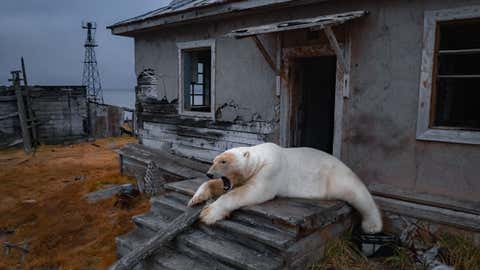Radar has long been used across the world to detect severe weather, airplanes, and other objects. But a collaboration between Polar Bears International and Spotter Global has developed a unique radar system in the Arctic.
They call it “Bear-dar.”
The innovation is only one of several high tech operations looking for new ways to protect polar bears, as climate change threatens the survival of the species.
Polar bears depend on sea ice to hunt seals, their natural prey. As summers have grown longer in the Arctic, the polar bears have to wait longer and risk running low on fat reserves as they wait on land for ice to arrive.
Landlocked, hungry polar bears can sometimes lead to dangerous human-bear interactions. That’s where Bear-dar comes in.
Following years of testing, the first operational version of the radar system has been installed in Eureka, Nunavut. Used as an early warning system, the radar can alert communities of approaching polar bears so they can use noisemakers and other non-lethal deterrents to drive the bear away.
“One thing with polar bears that we learned along the way is they’re sort of built to evade radar, in large part due to their fur. You think a large animal would be very easy to see and a hard target, but that thick fur makes them a very soft radar target,” says Geoff York, the Senior Director of Research and Policy at Polar Bears International.
Early tests in Churchill, Manitoba and the Assiniboine Park Zoo helped calibrate the radar, with the help of AI, to detect the distinct signature of a polar bear, rather than grazing caribou or people walking.

Polar Bear International is also rolling out a new mobile research and broadcasting hub that uses EV batteries, rather than a diesel engine, built to withstand Arctic temperatures.
“So the advantages from switching to the older diesel units to this fully electric model are multifold for us. One, this vehicle is silent. It can move across the tundra, you don’t even hear it coming. It’s fantastic for being around wildlife and not creating additional disturbance there. It’s also quite a bit more efficient and cost effective,” York said.
The challenges that polar bears face are severe.
The journal Science published a report earlier this year showing how the Western Hudson Bay polar bear subpopulation has declined by approximately fifty percent since 1979, driven by climate-driven sea ice loss.
Polar bears, York said, “are very much an ambassador for the Arctic at large. And they’ve become, unfortunately, an ambassador for the conservation issue that affects them the most, which is climate warming.”
Source: https://weather.com/




